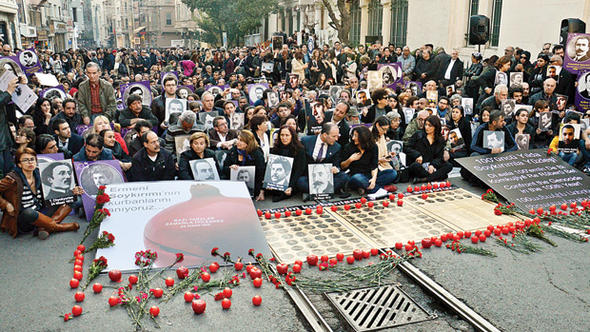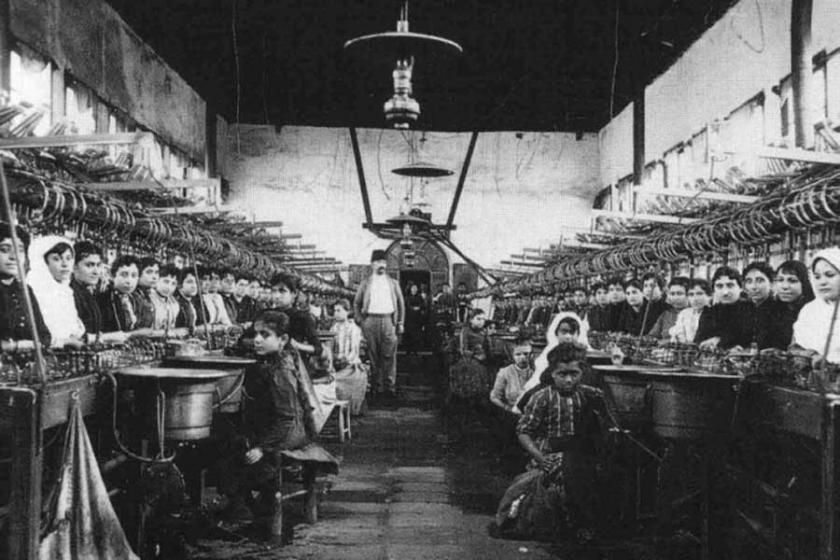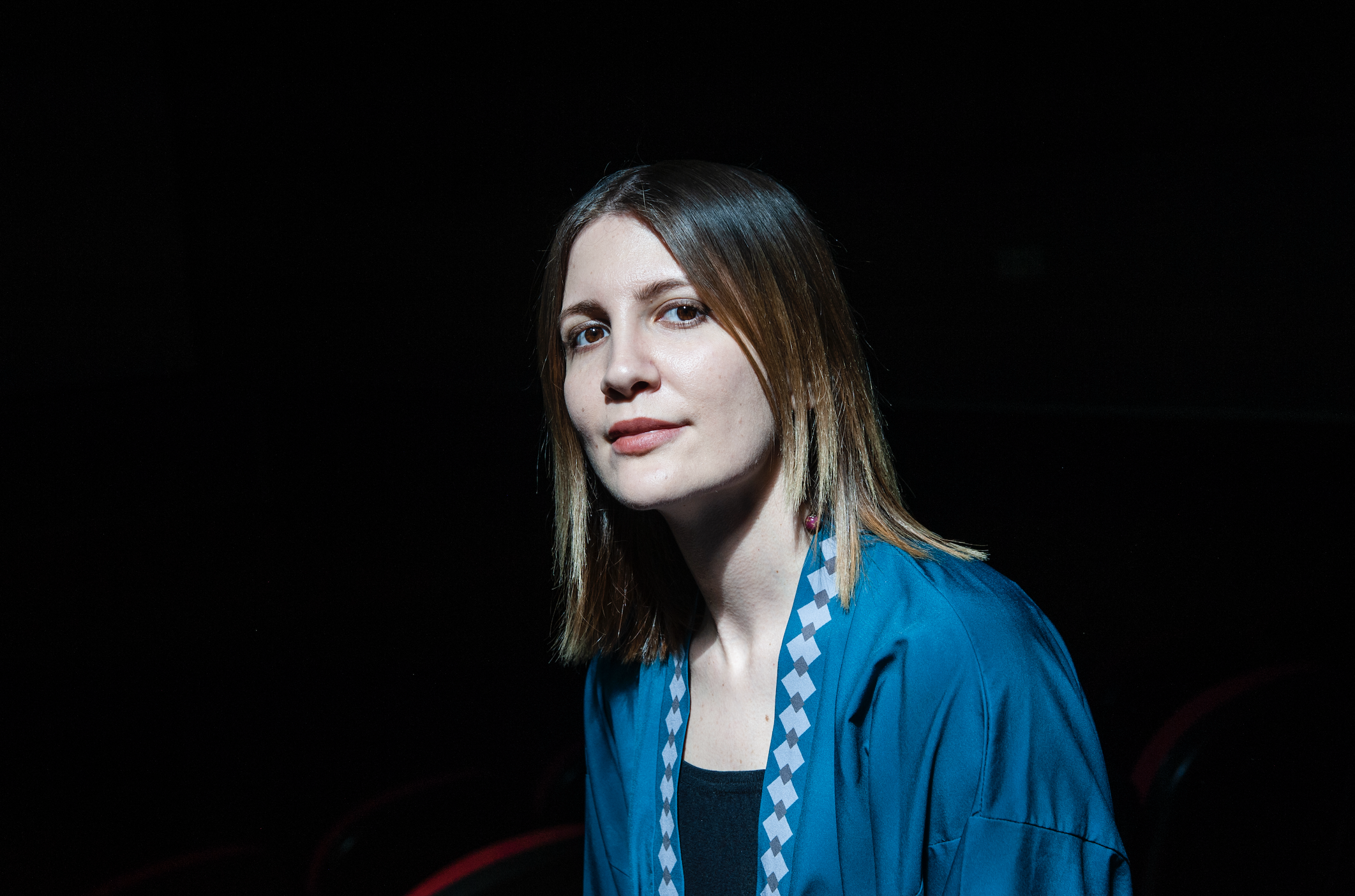In the early 2000s, the Armenian Genocide was commemorated publicly in Turkey. Today, it is not. Remembering changes those who remember. Drawing on archival research and interviews with people who participated in and even initiated such commemorations, I ask about the origins of such activism, what it represented, what happened, and what might come next. I then offer recommendations, in hope of deepening and making my own contribution to memory activism in Turkey.
ÖZGÜR SEVGİ GÖRAL*
In drafting this policy paper, I considered two questions:
-How do we, as stakeholders, individuals active in the Turkey’s intellectual milieu and memory activism space, prepare for the next time, when commemorating the Armenian Assyrian Genocide in the streets is possible? How can we prepare collectively for public memorial in Turkey?
-And what do we do now, while we are -partially- waiting, to strengthen ourselves, broaden our alliances and prepare for the next round?
1. The momentum of the 2000s and memory activism
In 1915, hundreds of thousands of Armenians and Assyrians were murdered, systematically, by the state. Today, in the Republic of Türkiye—the successor of the Ottoman empire that enacted that systemic violence—it is almost forbidden to name that crime as genocide. The Diyarbakır Bar Association and the central executive committee of the Peoples’ Democratic Party (HDP) face criminal investigations for insulting Turkishness, because of their public statements commemorating the Genocide. This was not always the case. Public commemorations were possible as recently as 2015. How did they come about?
At the start of this millennium, we had a window of opportunity for the struggles of democratization, human rights, and memory activism. Political and social movements in Turkey diversified, spanning ecological initiatives, new generation feminist platforms, left-wing initiatives discussing commons, anti-militarist groups, newspapers and journals on minority issues, memory activism and various LGBTQI+ organizations.
At the same time, civil society flourished. New NGOs appeared, supported by international funding including from the European Union. Established institutions such as Anadolu Kültür and the Human Rights Association also concentrated more on memorial work. The memorial issues in focus included other past atrocities alongside the Armenian Genocide. Hafıza Merkezi and DEMOS Research Association applied transitional justice mechanisms seeking to resolve the Kurdish conflict, which had claimed more than 40,000 lives since 1984. The Commission for Justice and the truth of Diyarbakır Military Prison/The Foundation of 78 documented the life stories of Kurdish inmates at Diyarbakır Prison (tortured after the 1980 coup). Karakutu Memory Association and ZAN İnstitute of Research labored for proper reconciliation, researching different approaches of peace building. Public intellectuals spoke up about past state crimes. The space for remembering diversified.
Other important developments coincided with these efforts from below. The Kurdish movement, already mobilized in the streets, forged new collaborations and alliances. Talks and negotiations emerged. Peace seemed possible, despite other contradictory developments. Importantly, in 2003 the Justice and Development Party (AKP) won a government majority. Here was a new political actor, with a declared program of “democratization”. This included more liberal approaches to the Kurdish conflict, and to relations with Armenia. Finally, the prospect of joining the European Union obliged the government to take concrete steps toward democratization, requiring commitments to the freedom of expression, implementation of fundamental human rights, and (more) equal citizenship for minorities in Turkey.
Looking back, interpreters agree: the democratic transformations of this period were neither complete nor fully implemented. Signs of repression remained intact. As one interviewee put it:
“ […] the Kurdish conflict was ongoing, the huge Armenian issue was very partially covered and there were always very contradictory moves of the government. But there was huge mobilization and pressure coming from the streets; we were in the street for our demands. This is a huge difference, and this is what made these commemorations possible.” [Interviewee]
This mobilization, a fragile resonance combining radical slogans in the streets with mainstream demands for a democratic transformation, was evident for all. This fresh momentum established the material and political basis that made public commemorations of the Armenian Genocide possible.
2. Significant developments on the road for genocide commemorations
Other important developments in Turkey also contributed to the momentum. Examples include the partial restitution of property seized from Armenian foundations, and the restoration of the Akhtamar church on an island in Lake Van. Intellectual knowledge production in Turkish on various aspects of the Armenian community in Turkey increased too. Despite exposure to many attacks, in September 2005 a three-day conference was held in Istanbul to discuss “Ottoman Armenians during the decline of the Empire: Scientific Responsibility and Issues of Democracy”. New public discourses on the so-called “Armenian issue” were disseminated in different media. In 2008, intellectuals launched a signature campaign entitled I Apologize. By January 2009, it had over 30,000 signatories. The text itself did not refer directly to the Armenian Genocide, nor even use the term genocide [“Great Disaster”], an absence criticized by activists.
“Words do matter. For me, not using the term genocide and framing it as an issue of consciousness is a real problem for a campaign dealing with the Armenian Genocide.” [Interviewee]
“I think ‘I Apologize’ campaign was important in the sense that it opened up a new venue for broader discussion of the Armenian issue. That is why I don’t criticize harshly despite its loose terminology.” [Interviewee]
Finally, the assassination of Hrant Dink had a tremendous impact. Dink had co-founded an Armenian independent newspaper, published in Turkish and in Armenian—Agos—in 1996. At the time of his death, he was editor-in-chief. Dink’s journalism and activism were so influential he was targeted by the nationalist and extreme right groups and (some) state officials. His series on the life trajectory of Armenian Genocide orphans was especially prominent. A public campaign against him attacked and criminalized his work, culminating in the initiation of criminal procedures against him. His assassination on January 19, 2007, in front of his office, at Agos triggered huge anger. Thousands attended his funeral. As a recent and unacceptable injustice, Hrant Dink’s assassination accelerated efforts to recognize the Armenian Genocide. Public commemorations in İstanbul grew.
“The killing of Hrant Dink was a milestone. Genocide recognition, the commemorations, everything related to the Armenian issue was considered differently after his assassination. The guilt and feeling of responsibility radically changed with this tragic violence.” (Interviewee)
3. Public commemorations of the Armenian Genocide
The first civic activity concerning the Armenian Genocide and using the word “genocide” was held by the Commission Against Racism and Discrimination (Commission) of the Human Rights Association (IHD), in Istanbul, in 2005. The Commission demanded recognition and apology from the Turkish state. As the pioneer of public commemorations, the Commission memorialized the Armenian Genocide each 24 April, beginning in the conference room of their İstanbul branch. From 2010 onwards, the Commission occupied two public places: Memorial events were held at Haydarpaşa Train Station, where Armenian intellectuals had been taken for deportation. The Commission also held commemorations at the Turkish and Islamic Arts Museum (former Ibrahim Pasha Place), where Armenians had been held before the forced expulsions.
The building sits at the heart of Sultanahmet Square, İstanbul’s historical center and the location of the Ottoman imperial court. Choosing such space shows the political attitude of the Commission par excellence: revealing the meaning of the crime scenes and naming the crime took priority. Their press releases listed three demands: restitution of the Armenian community's seized property; reparations to mitigate the damage; and the establishment of spaces of memory dedicated to the Armenian genocide.
“Demands, requests, and wishes of Armenians, who were taken from their homeland and scattered all over the world as a result of the Genocide, to compensate for their losses, which cannot be counted, should be responded. Denial is also an obstacle in front of such a process of reparation and justice. That's why we've been making a call for years: Genocide, Recognize, Apologize, Reparation!” (Press release of the Commission, 2018)
In 2010, a separate initiative began to organize a public commemoration on İstiklal Avenue. One of the most crowded places of Istanbul, this street intersects with Galatasaray Square. Who were these activists? Underpinned by the so-called DurDe! Initiative (Halt to Racism and Nationalism), they labelled this effort as The Platform of Commemorating 24 April, organizing in parallel with the IHD Commission. Mostly, they were left-wing liberal/progressive intellectuals and/or activists from the Revolutionary Socialist Workers Party (DSİP). On the big commemoration banner the slogan read “This pain is our common pain”. Some sort of Armenian music with the traditional instrument, duduk, played. These commemorations gathered an important number of participants, peaking at around 1000 persons. Some criticized the slogan, and the early press releases, for failure to name the genocide. But the choice of date was clear. Protestors knew what they were attending.
“It is true that the press release, and the name of the event did not name the genocide the first year. I also criticized it. One should not forget, however, it has always been a commemoration of the Armenian Genocide, for those who were attending and for those who were attacking it.” (Interviewee)
These commemorations represent a crucial moment in the Republic of Turkey’s history: they were the culmination of accumulated struggles against a nationalist mainstream denialist narrative. Despite the criticisms made, they constituted acknowledgement in the public sphere. More importantly, if their conglomerated impact seems very weak today, they provided a strong foundation. Of course, participants could imagine a more sophisticated memory scene. Yes, activists criticized wording and format. Yet almost everyone agreed on the importance of struggling and organizing together, despite all the difficult discussions. At the hundredth anniversary of the Armenian Genocide, remembrance was visible.
4. The blockade of the public space and the demise of the commemorations
This picture changed quickly. In [month] 2015, the Kurdish conflict resumed. The recommencement of the armed conflict confirmed the end of the publicly announced peace process. The demise of the peace process had a knock-on effect for those working to persuade the Turkish state to deal with the past. The coup attempt of 17 July 2016 and the state of emergency declared immediately after, blocked the streets for political protest and memory activism in Turkey. Dissidents disappeared from the streets. Alternative commemorative activity no longer felt safe. On top of this, new versions of denialism increased. Nationalism, chauvinism, and denialism became widespread in social media. Historical revisionism took on new forms. Openly anti-Armenian and genocidal statements prevailed in the public sphere. “It was not a genocide but rather an act of self-defense, and we will do it again when necessary” summarizes aptly the mentality of the post-2015 period.
5. Future prospects: a cause for hope
Even pre-2015, the commemorations did not occur without opposition. Some opponents held protests, with at least three different rationales on display: Nationalist groups gathered in small numbers, bringing Turkish and Azerbaijani flags. Their banners condemned “Cruelty of Armenians vis-à-vis Turks”. A second group was composed of denialist intelligentsia or state officials—retired colonels, diplomats, writers. In their hands, they held photographs of diplomats assassinated by the Armenian Secret Army for the Liberation of Armenia (ASALA). The third group were “anti-imperialists” or “denialists from the political left”, a group of protesters naming themselves radical left, from the organization entitled People’s Liberation Party (HKP). For them, the struggle for the recognition of the Armenian Genocide was part of an imperialist conspiracy. And the commemorations offered an opportunity to protest “the lies of imperialism”. None of these groups was large, and together they did not pose a terminal threat for the commemorations. Yet they added to the already tense political atmosphere. Meanwhile, organizers received death threats by email. The political climate that surrounded commemorations was nothing if not contentious. On the extreme right, Ümit Özdağ and others expressed hard lines of denialism, repeatedly attacking the commemorations in articles, speeches, and statements on the national media.
"It is the natural, I would say, consequence of the existing political atmosphere. For almost 10 years, nationalism, racism, and chauvinism increased massively. Ümit Özdağ is a perfect example showing this tendency, but I think there is a whole political conjuncture, structure, and official discourse behind him. "(Interviewee)
Today commemorations continue in closed-door meetings. The IHD Commission makes annual statements on 24 April, continuing the demands for recognition, reparation, and apology with a strong voice. Knowledge production on the Armenian Genocide and the Armenian community continue in Turkish. Aras Publishing House, Agos, Hrant Dink Foundation and Yeseyan Saloon publish new work, facilitate panels and workshops, and open new spaces of encounter. The streets seem silent since the state almost totally blocked them, closing those avenues of memory activism. Despite this, the accumulation has not stopped: for a more diverse narrative, a more inclusive collective memory, and to erode genocide denial.
6. Recommendations
It is always difficult for a researcher to make recommendations for the people struggling on the ground, especially during these dire times. Ongoing threats and actions of the Turkish state mean activists are struggling against the odds. But there are different audiences, and different stakeholders, and so in these recommendations I imagine what my interviewees might want to say and what there still might be that we can do together.
For that purpose, I return to my original questions (how we prepare, and what do we do while we are waiting) and offer some tentative answers, in line with the aim of this policy paper, e.g., deepening the debate of memory activism.
For institutions and NGOs
-Bring attention to the Armenian Genocide in other ways—not only commemorations. Foster and take part in academic workshops, political gatherings, and grassroots events to examine the Ottoman era and Turkey’s past.
-Address diversity and intersectionality cutting across divides: recognize the resilience of the Armenian community and its continued existence; study the multi-ethnic characteristics of the Ottoman, Turkish and Kurdish working classes; acknowledge the contribution of Armenian women to the early feminism debate. This approach recognizes and honors the diverse and multi-dimensional existence of the Armenian community in Anatolia.
-Organize solidarity for the activists facing judicial procedures because of their recognition of the Armenian Genocide. Follow the judicial situations, monitor the trials.
-Establish alliances and coalitions to imagine diverse and eclectic genocide commemorations, at national and international levels. Work together despite diverging perspectives and motivations. Stay in relation despite debates.
-Design and deliver educational programmes for young people. These programs may be organized with different groups of age, in different institutions and with different outputs.
For those too young to remember the time of memorials:
-Pay attention to those who are producing knowledge.
-Read about the Armenian Genocide.
-Know and disseminate the Armenian culture present in Anatolia today.
For those who, like me, recall what we did and mourn what we have lost:
-Remind ourselves and a broader public that public commemoration of the Armenian Genocide was possible, and it was not that long ago.
-Build websites to record the era of memorials. Incorporate archival resources and interviews.
Further reading
-Adnan Çelik, The Rise and Fall of Kurdish ‘Memory Work’ on the Armenian Genocide, Kurdish Peace Insitute, 1 July 2022, https://www.kurdishpeace.org/research/civil-society/the-rise-and-fall-of-kurdish-memory-work-on-the-armenian-genocide/
-Egemen Özbek, Yeni bir Hatırlama Kültürü ve Ermeni Soykırımı Anmaları, Birikim, no. 392 (December 2021): 60 – 69.
-Hamit Bozarslan, Soykırımın İdeolojik, Demografik ve Ekonomik Varlığı, in Yüz Yıl Sonra Ermeni Soykırımı. Araştırmalar, Tartışmalar, ed. Ermeni Soykırımı Araştırmaları Uluslararası Bilim Konseyi, İletişim Yayınları, 2016, 135 – 147.
-Nisan Alıcı, Confronting the Armenian Genocide in Turkey: A Transitional Justice Approach, Kurdish Peace Insitute, 24 April 2023, https://www.kurdishpeace.org/research/conflict-resolution-and-peacebuilding/confronting-the-armenian-genocide-in-turkey-a-transitional-justice-approach/
-Seyhan Bayraktar, Remembering the Armenian genocide in contemporary Turkey, Testimony Between History and Memory, n°120 (April 2015): 61 – 69.
-Talin Suciyan, Toplumsal Anma Pratikleri Şekillenirken, Bölüm II: İstanbul 24 Nisan 2015, Azad Alik, 21 June 2015, https://azadalik.com/2015/06/21/toplumsal-anma-pratikleri-sekillenirken-bolum-ii-istanbul-24-nisan-2015/
*Dr. Özgür Sevgi Göral. Visiting Scholar at the University of Cambridge and participant in a Turkish-Armenian relations research scheme hosted by the Cambridge Interfaith Programme and funded by the Calouste Gulbenkian Foundation. She is also co-founder of Hafıza Merkezi.
Disclaimer: The views expressed in this piece are those of the author and do not reflect the views of the Calouste Gulbenkian Foundation.





